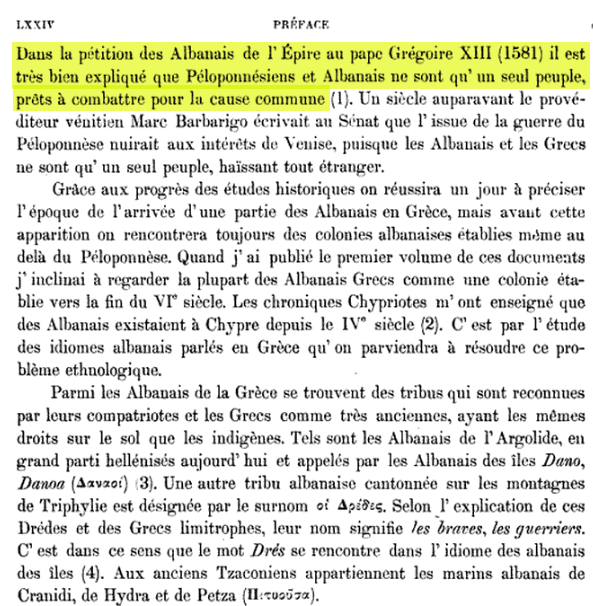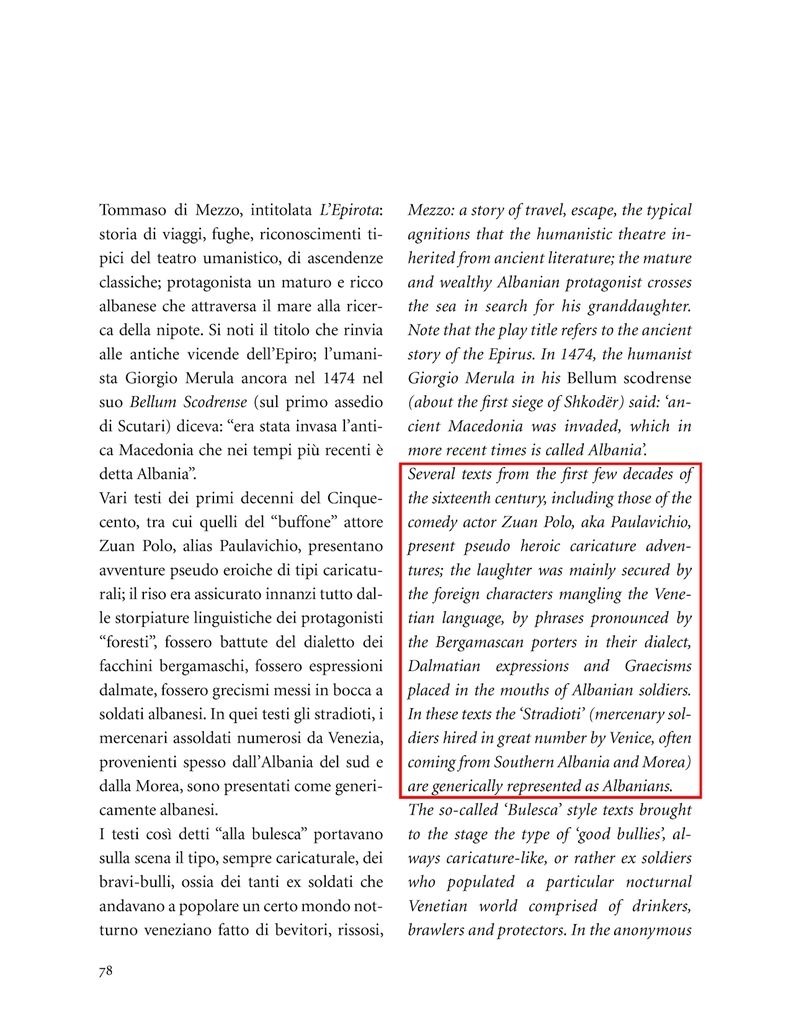Ethnic map showing where Albanian was spoken in the Peloponnese, 1890!
Collapse
X
-
Many Albanians were Hellenized before 19th century. That's why I asked.Originally posted by Amphipolis View PostThis was discussed (again) recently here (includes numbers and estimations by Greeks and Albanians):
http://www.macedoniantruth.org/forum...057#post167057
Comment
-
-
Documents inédits relatifs à l'histoire de la Grèce au Moyen âge publiés, By Konstantinos N. Sathas
PREFACE, Page LXXIV:
"In the petition of Albanians of Epirus to Pope Gregory XIII (1581), it is explained very well that Peloponnesians and Albanians are one people, ready to fight for the common cause."
 Last edited by Carlin; 05-13-2017, 11:18 PM.
Last edited by Carlin; 05-13-2017, 11:18 PM.
Comment
-
-
Irene Pappas or Irene Leleku:
"I look like my mother. My mother was dark like me. She came from Epirus, while my father probably came from Albania. Maybe I am Albanian, or half Albanian. Peloponnese is full of Albanians.''
According to one comment Bekim Fehmiu (Kosovo Albanian) (the protagonist Odyssey - of the movie L'Odissea ) claimed that Irene was of Albanian ancestry. However this ones seems suspicious.Last edited by tchaiku; 10-14-2017, 07:53 AM.
Comment
-
-
This explains everything:
I fratelli resistettero con successo all'invasione, ma al costo di devastare la campagna della Morea, con i Turchi poterono deportare circa 60.000 civili arvaniti ovvero albanesi dal loro territorio. Murad II, il sultano ottomano, concluse un trattato di pace che costringeva i despoti a pagare un pesante tributo annuale, a divenire vassalli dell'Impero Ottomano e di rimanere neutrali in caso di conflitto con le rimanenti parti dell'Impero Bizantino.
In 1446, the Ottomans invaded the Byzantine Morea which was then jointly administrated by the two brothers, the Despots Constantine and Thomas Palaiologos. The brothers successfully resisted the invasion, but at the cost of devastating the countryside of the Morea, and the Turks carrying off 60,000 ''Greek'' civilians back to their territory.
So the so called Greeks are Orthodox Albanians. (about the Morea revolt)Last edited by tchaiku; 02-24-2018, 03:48 PM.
Comment
-
-
On the site of the researcher Dimitris Lithoksou (Lithoksou.net), was published the complete list of Albanian settlements, the Arvanite ''heads'' obtained from the aforementioned publication (ref. Ονοματεπώνυμα των Αλβανών (Αρβανιτών) της βορειοδυτικής Πελοποννήσου τον 15ο αιώνα ). Turkish Ottomanologist Levent Kayapinar, based on his research on both Defter's fragments during 2009, reaches the following conclusions (out of 567 villages all over the Peloponnese, 411 were inhabited by Albanians, while 152 villages were inhabited by Greeks, and 4 villages were with mixed households, the number of heads of households corresponds to: Arbërorët with 4769 households and Greeks with 6473 households where 57.58% result in RUM\ Greek and 42.42% Arbeshe \ Arvanites) ref. The Ottoman Conquest of the Morea (1387 - 1460), f.9-14.
My opinion: Keep in your mind that Greek villages (RUM) might have contained Albanian families because they were much larger and advanced due to the power of the Greek church so the total Albanian families could've been over 50% but that is just a hypothesis.Last edited by tchaiku; 04-14-2018, 09:25 AM.
Comment
-
-
Can you rewrite that because it's hard to follow? What exactly did Lithoxoou, the Turkish and the Albanian authors do? Which era does that refer to? Which area and which Ottoman or Greek census data? Lastly, do they classify and count population of villages only? Do they exclude towns and cities?
Comment
-
-
This is an Ottoman census which includes taxed Orthodox Christian families; divided in Albanians (Arnavud) and Greeks (Rum). Other Orthodox Christians are not mentioned (they are counted as 'Rum'). It is the same census we saw last year about the northwestern Morea:Originally posted by Amphipolis View PostWhat exactly did Lithoxoou, the Turkish and the Albanian authors do?
It divided in two defters; one which includes North-Western Peloponnesus (in the link above), the other one the rest of the Peloponnesus. The total estimation by Georgios Liakopoulos:
7103 Families as RUM/ROMIOI 58/59%
4900 Families as Albanians/Arvanites 42/41%
It refers to 15th century, from 1460 to 1463Which era does that refer to?
The whole Peloponnesus. The defter is called Livāʾ-ı Mora.Which area and which Ottoman or Greek census data?
According to Lithoksou it includes towns two. This explains why Greeks zones being much smaller in number result in having the larger number of families in total.Lastly, do they classify and count population of villages only? Do they exclude towns and cities?
--------
One other thing that comes to my mind is that Albanian families having higher birth rates would have resulted in having a bigger population in total.Last edited by tchaiku; 04-14-2018, 11:40 AM.
Comment
-
-
I read a google translation of the Albanian link and I see several problems.
Do you have a link of the "other" part of the census, as it seems the added numbers of the two databases are not the whole of Peloponnese but less than half of it (i.e. NW and central).
Secondly, I'm a little confused on who made the classification to Romans & Arvanites. At some part it seems the Turkish documents classified each village, in other parts it is implied this is a result of calculations (the two ethnic groups paid for some reasons different taxes) or a process of the surnames recorded for each village?
Comment
-
-
I don't but I did find something that might clear things up. Unfortunately, I lost the link.Originally posted by Amphipolis View PostDo you have a link of the "other" part of the census, as it seems the added numbers of the two databases are not the whole of Peloponnese but less than half of it (i.e. NW and central).
The databases do not include the entire number of Christian families. The total number of Christian families of Morea during that time probably stood above 20,000. But let me do a calculation:
Northwest Peloponnese constitutes (Achaia and Ilia) which is about a quarter (or less) of Peloponnesian land. The total number of NW Peloponnese families was 3500. If we multiply 3,500 by 4 we get 14,000, which is close to total number families in the census. (12,000)
Ottomans favoured Albanians for the tax pay so for this reason Greeks and Albanians were distinguished. The classification was made according to language of the zone in which Ottomans had to communicate with.Secondly, I'm a little confused on who made the classification to Romans & Arvanites. At some part it seems the Turkish documents classified each village, in other parts it is implied this is a result of calculations (the two ethnic groups paid for some reasons different taxes) or a process of the surnames recorded for each village?Last edited by tchaiku; 05-30-2018, 10:23 AM.
Comment
-









Comment